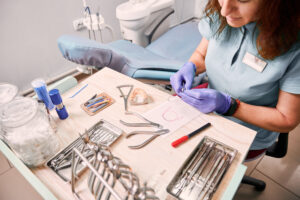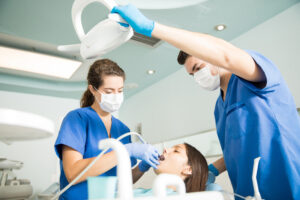Ever wondered what goes on behind that bright smile your dental hygienist gives you at every appointment? (Spoiler alert: it’s more than just scraping plaque and giving out free toothbrushes.) Dental hygienists are essential members of the oral healthcare team—balancing patient care, technical precision, and a good dose of empathy.
Whether you’re considering a career in dental hygiene or are just plain curious, this blog walks you through a typical day in the life of a dental hygienist—with some real talk, a few laughs, and plenty of helpful insights.
Morning Routine and Gearing Up for the Day
The day starts early—most dental hygienists clock in before 8:00 AM. (Coffee: mandatory. Alarm clock: unforgiving.)
– They review the day’s patient schedule and prepare the treatment rooms.
– Instruments are sterilized meticulously. Infection control is serious business, and compliance with OSHA and CDC guidelines is non-negotiable.
– Before the first patient arrives, the hygienist reviews their medical history, dental charts, and any notes from the dentist.
This prep time is essential—think of it as stretching before a marathon… that includes mouths and mirrors.
Patient Appointments: Precision Meets People Skills
Dental hygienists typically see 8–10 patients per day, and every visit is a mix of science, art, and psychology.
Here’s what they tackle:
– Conducting dental cleanings—scaling (removing tartar), polishing, and flossing. If you feel like your teeth just joined a spa retreat, thank your hygienist.
– Taking and interpreting dental X-rays—because spotting cavities isn’t just about looking for trouble; it’s about seeing what lies beneath.
– Applying preventive treatments like fluoride varnishes or dental sealants.
– Educating patients about oral hygiene habits. Ever been guilt-tripped about not flossing? That’s their job. Lovingly, of course.
– Communicating findings with the dentist and documenting everything meticulously.
It’s part health coaching, part detective work, and part dental acrobatics. (Have you ever tried working upside down in someone’s mouth while making small talk?)
Breaks, Charting & Midday Catch-Ups
Breaks are short but sacred.
– A typical hygienist gets a short mid-morning breather and a 30-minute lunch.
– Some use this time to catch up on charting, restock supplies, or sneak in a quick neck stretch. (Back pain is an unofficial part of the job description.)
– Others regroup with the dental team to plan for the afternoon or troubleshoot patient issues.
While it’s not exactly “quiet time,” it’s a pause before diving back into more pearly whites.
Afternoon Appointments & Special Cases
Afternoons might involve:
– Pediatric patients who may scream, squirm, or ask 87 questions.
– Nervous adults with dental anxiety (cue calm voices and reassurance).
– Deep cleanings (scaling and root planing), which require extra care and time.
– Follow-ups for periodontal therapy or whitening procedures.
At the end of the day, the hygienist sterilizes instruments again, resets the rooms, and updates digital records. It’s about leaving the clinic ready for tomorrow.
Skills That Set Great Hygienists Apart
Not everyone’s cut out for this role. Successful dental hygienists bring a unique set of qualities to the chair:
– Attention to detail (because teeth don’t lie).
– Dexterity and physical stamina (8 hours of leaning over patients isn’t for the faint-hearted).
– Strong communication and empathy.
– Ability to stay calm, even when faced with stubborn tartar or nervous patients.
– A sense of humor doesn’t hurt either—especially when reminding someone it’s been three years since their last cleaning.
What Real Hygienists Say
“It’s incredibly rewarding to help patients overcome their fear of the dentist—and to see their confidence grow with every visit.” — Kelsey, RDH
“The most challenging part? Managing back pain while smiling and talking about flossing.” — Michael, RDH
Behind every bright smile is a professional who cares deeply—and probably needs a massage.
Career Path & Opportunities
To become a dental hygienist, you typically need:
– An associate degree in dental hygiene (from an accredited program).
– A passing score on the National Board Dental Hygiene Examination.
– A state-specific license to practice (requirements vary).
Career paths can lead to:
– Specialization in periodontics or pediatric dentistry
– Public health outreach
– Teaching at dental hygiene schools
– Sales or consulting in the dental products industry
Many hygienists also enjoy flexible scheduling and part-time options, making it appealing for work-life balance seekers.
FAQs about Dental Hygienist
Q1. How many patients does a hygienist typically see per day?
👉 Usually 8–10, depending on appointment types and office pace.
Q2. Do hygienists work weekends?
👉 It depends on the practice. Some dental offices offer weekend hours for working professionals.
Q3. Is it physically demanding?
👉 Yes, repetitive movements, standing, and awkward postures can cause strain. Ergonomic training is key.
Q4. What’s the difference between a dentist and a hygienist?
👉 Dentists diagnose and treat dental issues; hygienists focus on preventive care like cleanings and oral health education.
Q5. Can hygienists administer local anesthesia?
👉 In many states, yes—but they need additional certification.
Conclusion
A dental hygienist’s day is packed with care, precision, and a healthy dose of personality. It’s a profession that’s as rewarding as it is demanding—one that dental hygienist recruitment agencies seek passionate, people-focused candidates for, especially those who thrive in healthcare and don’t mind spending their day face-to-face with plaque..





